Summary: A tailwind for the rally since February 2016 has been the bearish positioning of investors, with fund managers persistently shunning equities in exchange for holding cash.
Fund managers have become more bullish, but not excessively so. Profit expectations are near a 7-year high and global economic growth expectations are near a 2-year high. However, cash balances at funds remains high, suggesting lingering doubts and fears.
Of note is that allocations to US equities dropped to their lowest level in 9 years in April: this is when US equities typically start to outperform. In contrast, weighting towards Europe and emerging markets have jumped to levels that strongly suggest these regions are likely to underperform.
Fund managers remain stubbornly underweight global bonds due to heightened growth and inflation expectations. Current allocations have often marked a point of capitulation where yields reverse lower and bonds outperform equities.
For the fifth month in a row, the dollar is considered the most overvalued in the past 11 years. Under similar conditions, the dollar has fallen in value in the month(s) ahead.
Among the various ways of measuring investor sentiment, the BAML survey of global fund managers is one of the better as the results reflect how managers are allocated in various asset classes. These managers oversee a combined $600b in assets.
The data should be viewed mostly from a contrarian perspective; that is, when equities fall in price, allocations to cash go higher and allocations to equities go lower as investors become bearish, setting up a buy signal. When prices rise, the opposite occurs, setting up a sell signal. We did a recap of this pattern in December 2014 (post).
Let's review the highlights from the past month.
Cash: Fund managers' cash levels dropped from 5.8% in October 2016 to 4.9% in April. Recall that 5.8% was the highest cash level since November 2001. Cash remained above 5% for almost all of 2016, the longest stretch of elevated cash in the survey's history. Some of the tailwind behind the rally is now gone but cash is still supportive of further gains in equities. A significant further drop in cash in the month ahead, however, would be bearish. Enlarge any image by clicking on it.

Global equities: Fund managers were just +5% overweight equities at their low in February 2016; since 2009, allocations had only been lower in mid-2011 and mid-2012, periods which were notable bottoms for equity prices during this bull market. Allocations in April have increased to +40% overweight, which is slightly above neutral (0.5 standard deviations above the long term mean). Outside of 2013-14, over +50% overweight has historically been bearish (dashed line and shading).
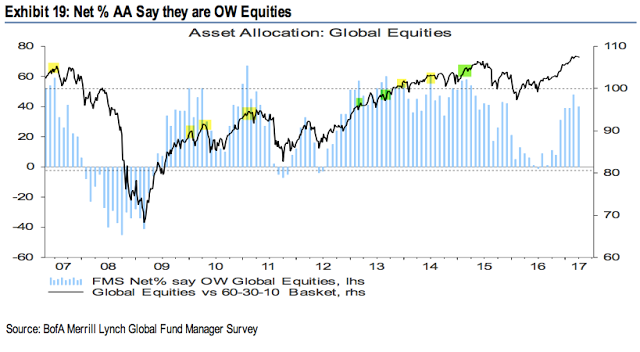
In February 2016, more than 20% of fund managers believed profits would be weaker in the next 12 months, the lowest since 2012. They are now optimistic: 50% expect stronger profits in the next year, near a 7-year high. Pessimism explained their prior low allocation to equities and high allocation to cash; that has now changed.
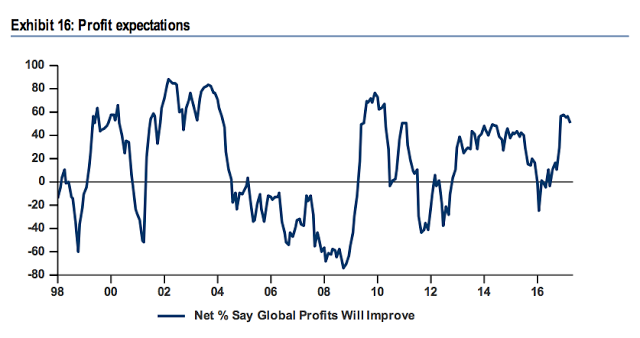
Similarly, most expect a better economy in the next year, near a 2-year high. This also explains their enthusiasm for equities.
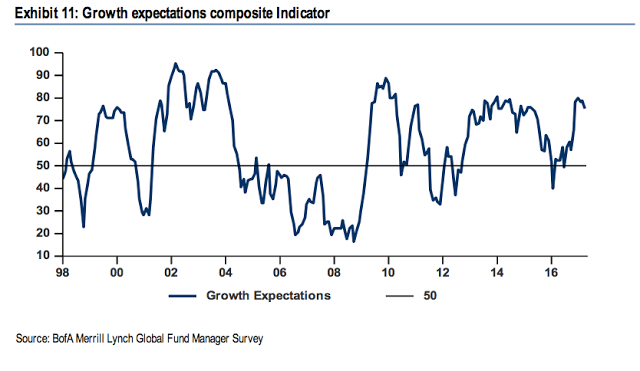
US equities: Fund managers were consistently and considerably underweight US equities for a year and a half starting in early 2015, during which US equities outperformed. That changed in December 2016, with fund managers becoming +13% overweight, and they remained overweight through February: bearish sentiment was no longer a tailwind for US equities and US equities underperformed their global peers. Fund managers have now dramatically dropped their allocation to -20% underweight, the lowest since January 2008 (0.8 standard deviations below its long term mean). This is where US equities typically start to outperform again. Above +20% overweight and sentiment typically becomes a strong headwind (dashed line).
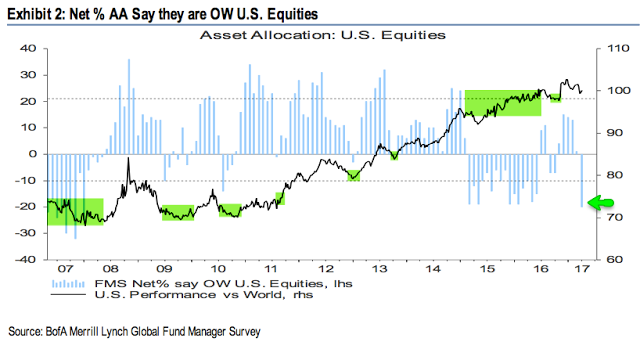
European equities: In contrast, fund managers had been excessively overweight European equities in 2015-16, during which time EZ equities underperformed. That changed in July 2016, with the region becoming underweighted for the first time in 3 years. European exposure jumped to +48% overweight in April, a 15-month high. This is well above neutral (1.5 standard deviations above its long term mean). European equities are at high risk of underperforming.
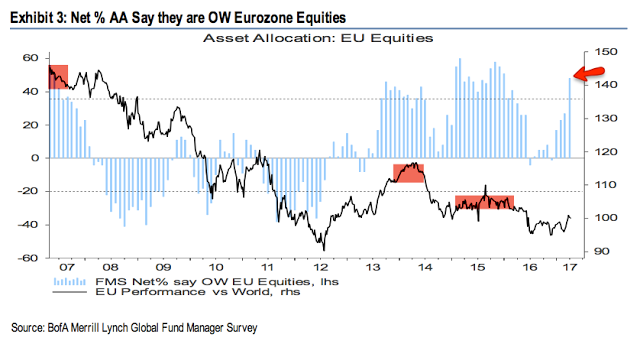
Emerging markets equities: In January 2016, allocations to emerging markets fell to their second lowest in the survey's history (-33% underweight). As the region outperformed in 2016, allocations rose to +31% overweight in October, the highest in 3-1/2 years. That made the region a contrarian short: emerging equities then dropped 10% in the next two months. Allocations fell to -6% underweight in January, making the region a contrarian long again: the region has since outperformed. This month, allocations jumped to +44% overweight, a 5-year high (1.1 standard deviations above its long term mean). Emerging market equities are at high risk of underperforming.
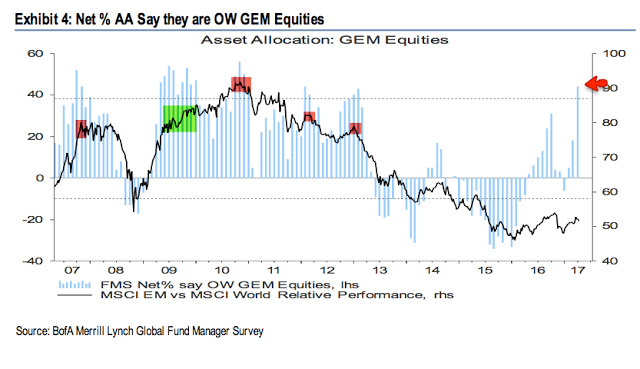
Global bonds: Fund managers are -62% underweight bonds, a fall from -35% underweight in July 2016 (which was near a 3-1/2 year high allocation). This is 1.0 standard deviations below its long term mean and near a more than 3-year low. A capitulation low in the past has often occurred when bonds were -60% underweight (shading and dashed line). In other words, bonds are now a contrarian long. Note the failure in 2013.

Of note, fund managers' inflation expectations in March were at the highest level in 13 years. This explains some of the sell off in bonds in the past half year. It's notable that current levels have marked at least a short-term reversal point in yields in the past (lower panel).
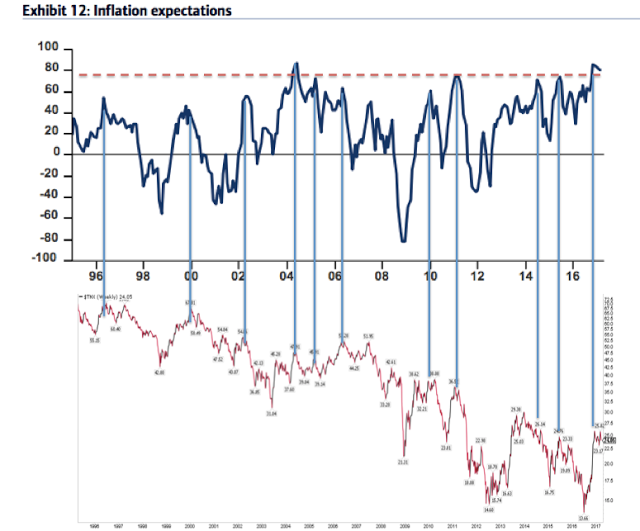
Similarly, fund managers' growth expectations are at the highest level since early 2011, at which time yields fell (highlights).
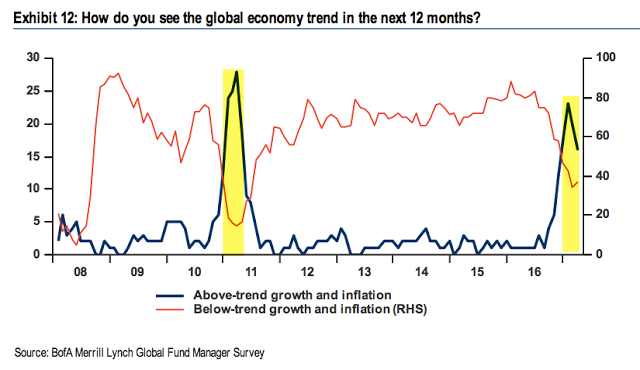

Commodities: Allocations to commodities remain near a 4-year high (-4% underweight). This is neutral (0 standard deviations above/below its long term mean). In comparison, in February 2016, allocations were near one of the lowest levels in the survey's history (-29% underweight). The improvement in commodity allocations goes together with increased macro optimism.
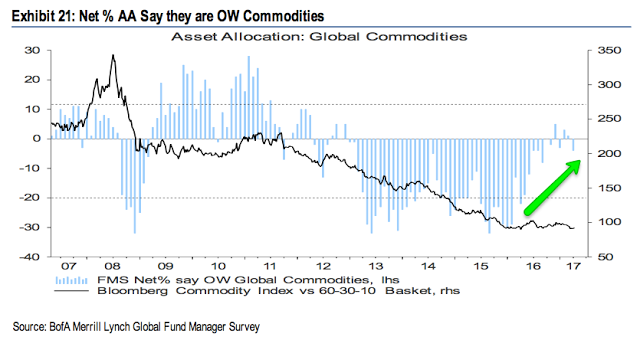
Sectors: Relative to history, managers are overweight equities and very underweight bonds. Cash weightings are neutral. US equities are significantly underweight relative to history, while Europe and emerging markets are significantly overweight.
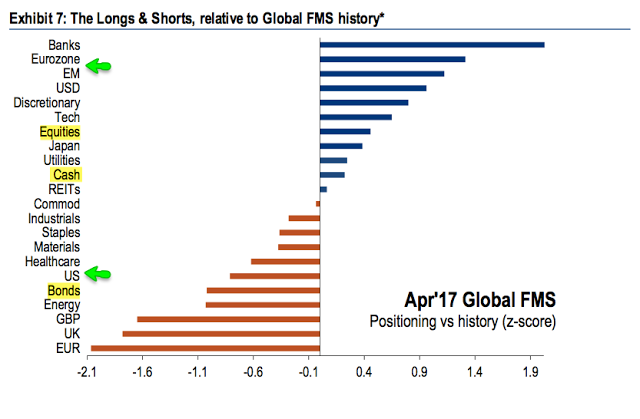
Dollar: Since 2004, fund managers surveyed by BAML have been very good at determining when the dollar is overvalued. In March 2015, they viewed it as overvalued for the first time since 2009; the dollar index fell from 100 to 93 in the next two months. In late 2015, they again viewed the dollar as overvalued and the index lost 7%. Fund managers have viewed the dollar as overvalued since November 2016; since then, the dollar has lost about 3%. Under similar conditions (highlighted in green), the dollar has fallen in value in the month(s) ahead.

Survey parameters are below.
- Cash: The typical range is 3.5-5.0%. BAML has a 4.5% contrarian buy level but we consider over 5% to be a better signal. More on this indicator here.
- Equities: Over +50% overweight is bearish. A washout low (bullish) is under +15% overweight. More on this indicator here.
- Bonds: Global bonds started to underperform in mid-2010, 2011 and 2012 when they reached -20% underweight. -60% underweight is often a bearish extreme.
- Commodities: Higher commodity exposure goes in hand with improved sentiment towards global macro and especially EM equities.
If you find this post to be valuable, consider visiting a few of our sponsors who have offers that might be relevant to you.
